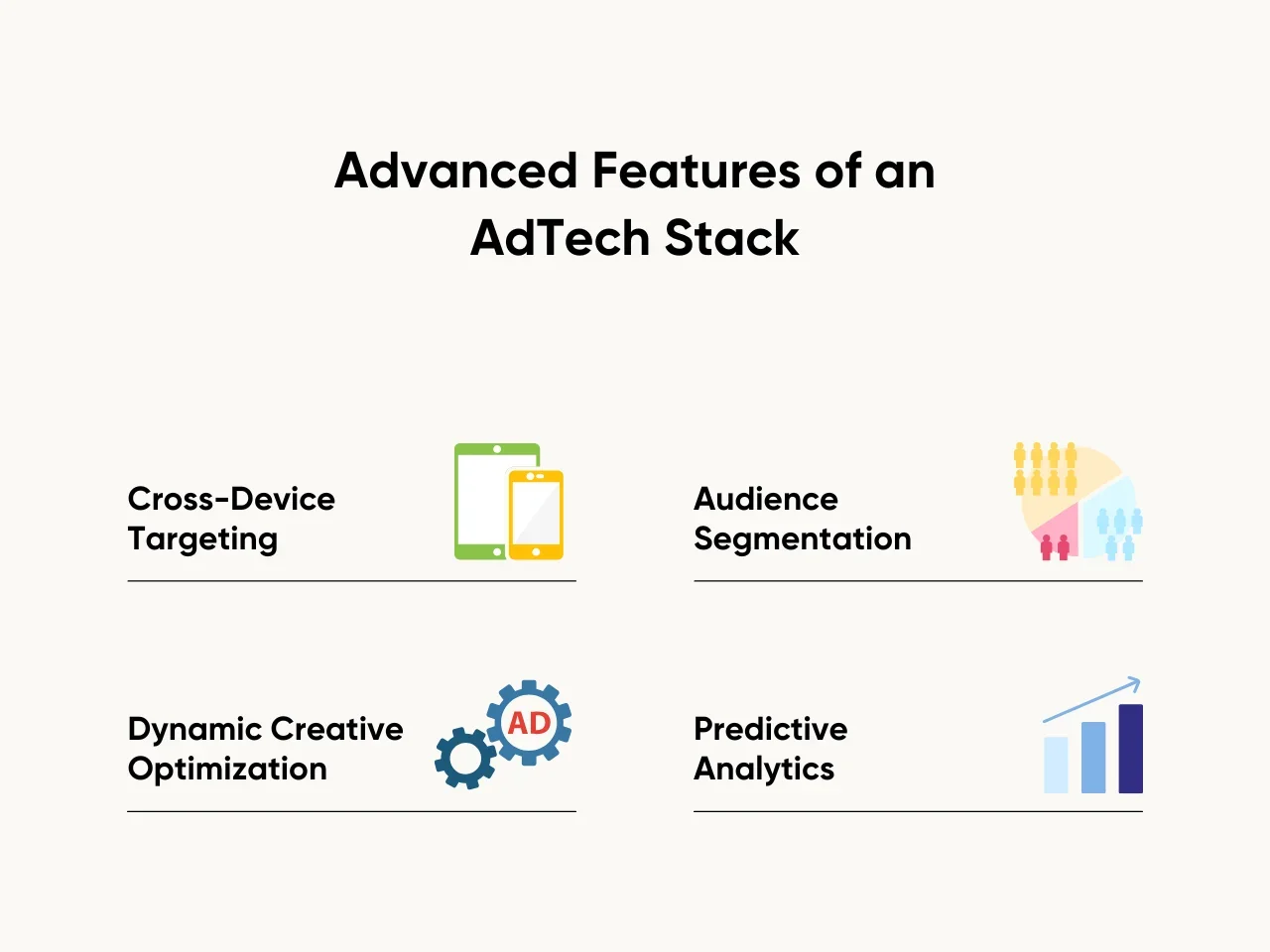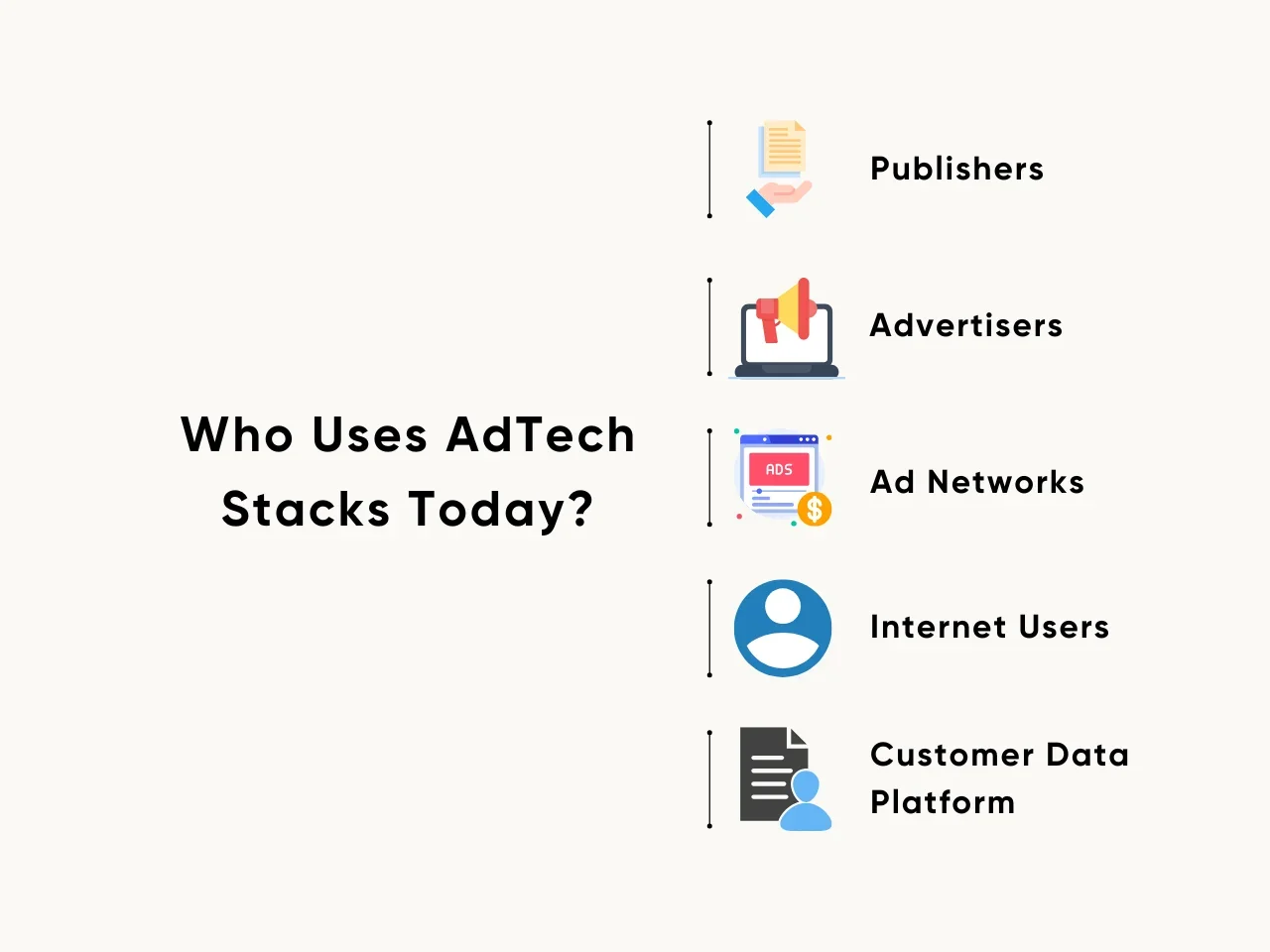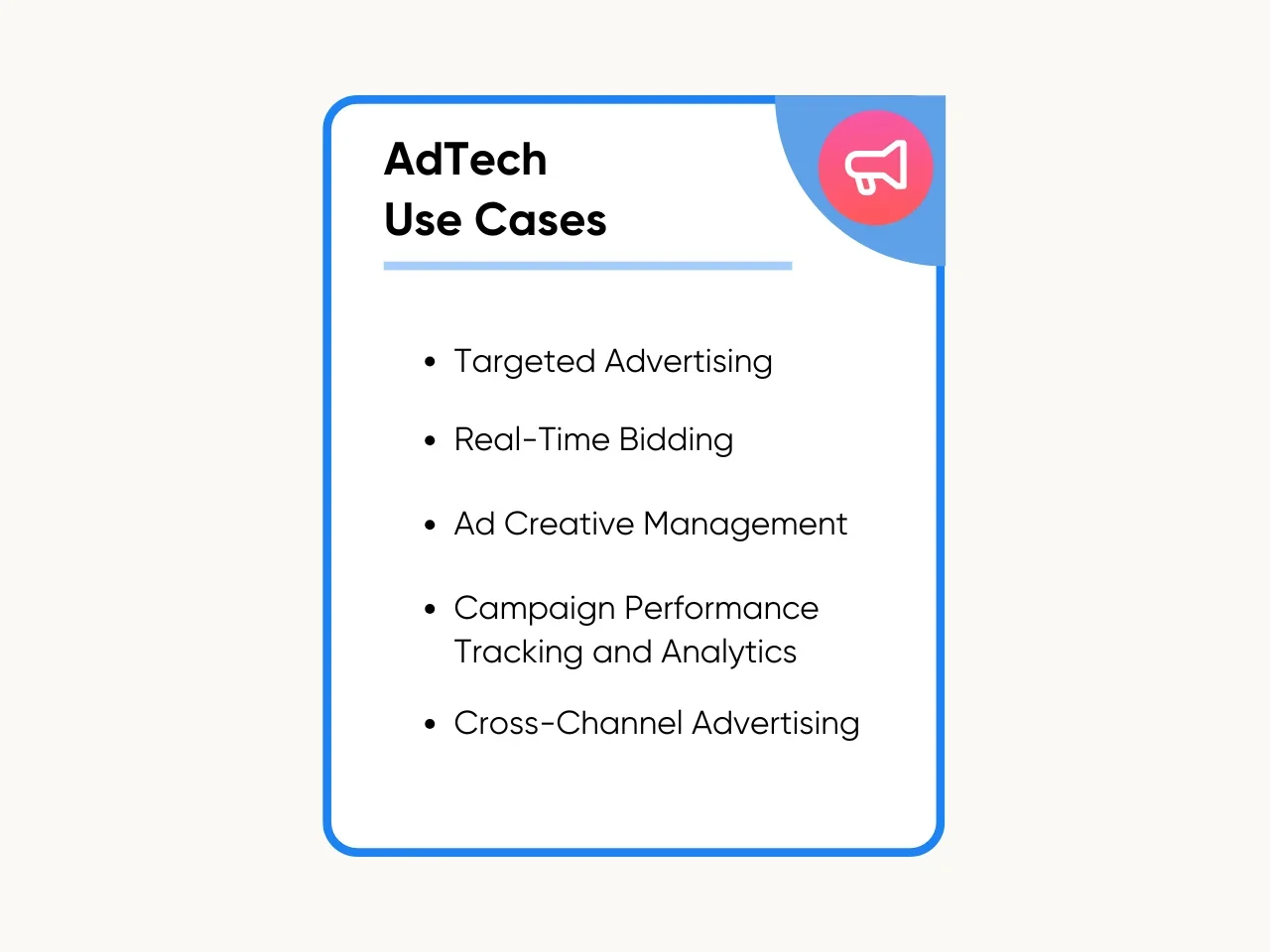The success of startup businesses in digital advertising hinges on a well-structured AdTech stack. This tech stack comprises various tools and platforms designed to streamline advertising processes, enhance targeting capabilities, and maximize ROI. By carefully selecting and integrating the right components into their AdTech stack, startups can efficiently manage ad campaigns, analyze audience data, and drive impactful marketing strategies.
Aloa, a reputable software outsourcing firm, specializes in developing custom solutions tailored to enhance adtech stacks for businesses globally. With a dedicated team of skilled professionals, Aloa provides high-quality software development services that meet each client’s unique needs, ensuring optimal performance and client satisfaction.
In this blog, we provide a comprehensive explanation of a tech stack for advertising by exploring its fundamental components, applications in modern advertising, and key features that drive its effectiveness. By the end, you’ll understand how an AdTech stack empowers startups to optimize efforts, enhance targeting, and maximize ROI.
Let’s dive in!
What is an AdTech Stack (AdTech Technology)?
An AdTech stack, or advertising technology stack, integrates software tools like demand-side platforms (DSPs), supply-side platforms (SSPs), ad exchanges, data management platforms (DMPs), and ad servers. This combination empowers businesses to manage and optimize digital advertising efforts, facilitating ad buying, selling, and delivery across various channels and devices.
In the AdTech ecosystem, advertisers leverage DSPs to purchase ad inventory from publishers via ad exchanges. In contrast, publishers utilize SSPs to manage and monetize their ad space. DMPs play a crucial role in collecting, analyzing, and segmenting audience data, enabling advertisers to target specific demographics with personalized ads.
This ecosystem relies on a robust tech stack for web development to ensure seamless integration and efficient operation. With the rapid evolution of technology and consumer behavior, businesses must continuously adapt and optimize their AdTech stacks to remain competitive in the dynamic digital advertising landscape.
Diverse Types of AdTech Stack
AdTech stacks come in various common types tailored to specific advertising needs and objectives. Here are the most common AdTech stack variations, each offering unique features and functionalities to optimize digital advertising efforts for businesses of all sizes and industries.
- Basic AdTech Stack: It consists of essential components like ad servers, DSPs, and ad exchanges, which are suitable for small businesses or those with more straightforward advertising needs.
- Advanced AdTech Stack: Incorporates additional components such as DMPs, customer data platforms (CDPs), and advanced analytics tools for more comprehensive audience targeting and campaign optimization.
- Programmatic AdTech Stack: Focuses on programmatic advertising, leveraging automated bidding and ad placement algorithms to efficiently buy and sell ad inventory in real time.
- Video AdTech Stack: Specifically designed for managing and optimizing video advertising campaigns, including components like video ad servers and video DSPs.
- Mobile AdTech Stack: Optimized for delivering and tracking mobile advertising campaigns, featuring components like mobile ad servers, mobile DSPs, and mobile attribution platforms.
Each AdTech stack caters to different advertising goals, audience segments, and channels, allowing businesses to customize their stack based on their specific requirements and budget constraints.
How To Build an AdTech Stack 2024
Building an AdTech stack in 2024 involves carefully selecting and integrating a combination of platforms and tools that cater to specific advertising needs. Here is how to build an effective AdTech stack to maximize audience engagement, increase conversion rates, and optimize ad spending across various digital channels.

Step 1: Understand Your Audience and Objectives
The first crucial step is understanding your target audience and overarching advertising objectives thoroughly, ensuring your message reaches the right audiences. This involves conducting comprehensive market research, analyzing consumer behavior data, and identifying key demographics and psychographics.
By gaining insights into your audience’s preferences, interests, and pain points, you can tailor your ad campaigns to resonate with them effectively. Additionally, defining clear advertising objectives is essential for guiding your AdTech stack strategy and measuring success.
Whether your goal is to increase brand awareness, drive website traffic, or boost sales conversions, aligning your AdTech stack components with these objectives is paramount. Understanding your audience and objectives sets the foundation for selecting the right adtech tools and platforms to best serve your advertising goals.
Step 2: Select Core Components
Core components are the foundational elements of an AdTech stack that form the backbone of advertising operations and campaign management. These components encompass various tools and platforms essential for executing advertising strategies efficiently and effectively.
Here are the essential core components to consider:

- Demand-Side Platform (DSP): Enables ad inventory purchase, audience targeting, and optimization across exchanges through real-time bidding for advertisers.
- Data Management Platform (DMP): Aggregates and activates data for detailed audience profiles, enabling precise targeting and personalization across digital channels.
- Ad Server: Delivers and manages digital ad campaigns, ensuring timely and targeted delivery while providing real-time reporting and optimization.
- Supply-Side Platform (SSP): Enables publishers to manage ad inventory, connect with demand sources, and maximize revenue through programmatic selling.
- CRM Integration: Integrates Customer Relationship Management (CRM) data for targeted advertising and personalized messaging, enhancing campaign effectiveness.
- Creative Management Platform (CMP): Facilitates creation, management, and optimization of digital ad creatives across formats and channels, improving campaign performance.
Selecting the appropriate core components ensures the AdTech stack is equipped to meet advertising objectives and deliver optimal results across various channels and devices, enhancing the overall advertising ecosystem.
Step 3: Integrate Header Bidding Solutions
In 2024, header bidding emerged as a fundamental component of an effective AdTech stack, revolutionizing how publishers optimize ad revenue. The integration of header bidding solutions allows publishers to offer their ad inventory to multiple demand sources simultaneously before making ad serving decisions, maximizing competition and revenue potential.
This step involves selecting and implementing header bidding wrappers or containers that facilitate the auction process across various demand partners, including ad exchanges and SSPs. Additionally, publishers must strategically configure their header bidding setup, including setting price floors and optimizing timeout settings, to achieve optimal yield management.
The integration of header bidding solutions requires careful consideration of factors such as latency management, user experience impact, and ad server compatibility to ensure seamless ad operation within the AdTech stack.
Step 4: Consider Advanced Features
In an AdTech stack, advanced features refer to cutting-edge functionalities that enhance campaign performance and efficiency. These features leverage sophisticated algorithms and technologies to maximize the effectiveness of advertising strategies.
Here are the advanced features to consider:

- Cross-Device Targeting: This feature enables advertisers to reach users seamlessly across multiple devices, ensuring a consistent and cohesive advertising experience throughout their online journey.
- Dynamic Creative Optimization (DCO): With DCO, ad creatives are personalized and optimized in real time based on user data. This ensures higher relevance and engagement for each viewer.
- Audience Segmentation: This functionality divides the target audience into specific groups based on various criteria such as demographics, behavior, or interests, allowing advertisers to deliver highly targeted and personalized messaging to each segment.
- Predictive Analytics: Predictive analytics provides insights into future trends and behaviors, enabling advertisers to optimize their campaign strategies for maximum effectiveness and ROI.
Integrating these advanced features can elevate your AdTech stack’s capabilities and drive better results for your advertising campaigns.
Step 5: Explore Video Advertising Solutions
Video advertising has become an integral part of digital advertising strategies, necessitating the inclusion of video advertising solutions in the AdTech stack. This step involves exploring and integrating video ad platforms that offer comprehensive features for creating, managing, and optimizing video content ad campaigns across various channels and devices.
Advertisers must assess the capabilities of video advertising solutions, including support for different video formats, targeting options, and measurement metrics to align with their campaign objectives. Additionally, integrating video advertising solutions requires compatibility with existing ad serving infrastructure and compliance with ad formats and delivery industry standards.
Publishers and advertisers should evaluate video ad platforms based on ad quality, viewability, and audience engagement to ensure maximum impact and ROI. With the rising popularity of over-the-top (OTT) and connected TV (CTV) advertising, selecting video advertising solutions that support these channels is essential for reaching audiences across all screens.
Step 6: Prioritize Brand Safety and Verification
In building an AdTech stack, prioritizing brand safety and verification ensures the protection of a brand’s reputation and credibility in digital advertising environments, safeguarding against potential risks and maintaining consumer trust.
Here are the key points to consider:
- Ad Fraud Prevention: Implement measures to detect and prevent fraudulent activities such as ad bots and invalid traffic, safeguard ad spending, and maintain campaign integrity.
- Content Verification: Utilize tools and platforms to ensure ads are displayed alongside brand-safe and contextually relevant content, minimizing the risk of association with harmful or inappropriate content.
- Brand Safety Controls: Employ settings and filters to control where ads appear and avoid placement on websites or platforms that could negatively impact brand perception or values.
- Transparency and Reporting: Demand transparency from ad partners and platforms, including detailed reporting on ad placements, viewability, and performance metrics to ensure accountability and compliance with brand safety standards.
Prioritizing brand safety and verification protects brand reputation and fosters trust with audiences in today’s digital advertising landscape.
Step 7: Adopt Identity Solutions
As privacy regulations evolve and consumer data becomes increasingly protected, adopting identity solutions is crucial for building a robust AdTech stack. This step involves integrating identity resolution platforms that enable advertisers to identify and target users across devices and channels while respecting user privacy preferences.
Advertisers must prioritize identity solutions that offer deterministic and probabilistic matching techniques to ensure accurate audience targeting and personalized advertising experiences. Additionally, identity solutions should support interoperability with other AdTech platforms and data management systems to facilitate seamless data sharing and activation.
By leveraging identity solutions, advertisers can overcome cookie restrictions and device fragmentation challenges, ensuring consistent user engagement and attribution across the customer journey.
Who Uses AdTech Stacks Today?
In today’s digital landscape, various stakeholders utilize adtech stacks to facilitate their advertising and marketing efforts. Here are seven key players who leverage adtech stacks:

- Publishers: Large publishers own digital advertising space and monetize online properties like publisher’s websites by selling ads to interested advertisers. They utilize AdTech stacks to optimize revenue generation and stay updated on advancements and trends in the ad tech ecosystem.
- Advertisers: Advertisers purchase digital advertising space to promote their products and services online. They rely on AdTech stacks to enhance customer engagement, optimize return on ad spend, and stay informed about audience engagement trends.
- Ad Networks: Ad networks, acting as intermediaries, aggregate and sell publishers’ ad inventory to interested advertisers, thus forming a crucial aspect of the ad tech ecosystem. They establish critical business relationships with publishers and advertisers, leveraging adtech stacks to efficiently manage the ad inventory of this expansive network of publishers.
- Internet users: The ad tech ecosystem also impacts regular internet users. They are concerned about how changes in the ecosystem affect their online browsing experience and personal data protection, influencing trends like contextually relevant advertising.
- Customer Data Platform (CDP) Providers: CDPs focus on collecting and analyzing first-party customer data, offering a solution to the end of third-party cookies. They play a crucial role in helping publishers and advertisers retain access to data for accurate audience targeting.
AdTech Use Cases
An adtech or advertising technology stack refers to the collection of software tools and technologies used by advertisers, publishers, and ad agencies to manage and optimize their digital advertising campaigns. Here are five everyday use cases for an AdTech stack:

Targeted Advertising
AdTech stack enables advertisers to leverage data analytics and audience segmentation to target their ads to specific demographics, interests, behaviors, and other criteria. Advertisers can create highly personalized and relevant ad campaigns by analyzing user data from various sources such as cookies, CRM systems, and third-party data providers.
Real-Time Bidding (RTB)
AdTech stacks often include RTB platforms that allow advertisers to bid for ad inventory in real time. Through automated auctions, advertisers can bid on impressions based on their targeting criteria and budget, ensuring their ads are displayed to the right audiences across various websites and apps.
Ad Creative Management
AdTech stack provides tools for creating, managing, and optimizing ad creatives across different formats and platforms. Advertisers can use these tools to design compelling ad content, test different variations, and analyze performance metrics to improve engagement and conversion rates.
Campaign Performance Tracking and Analytics
Ad stack offers robust analytics and reporting capabilities that allow advertisers to track the performance of their ad campaigns in real time. By monitoring metrics such as impressions, clicks, conversions, and ROI, advertisers can assess the effectiveness of their campaigns, identify improvement areas, and make data-driven decisions to optimize their advertising spending.
Cross-Channel Advertising
AdTech stack facilitates cross-channel advertising by integrating various ad networks, social media platforms, search engines, and other digital channels. This allows advertisers to reach their target audience across multiple touchpoints and devices, ensuring consistent messaging and maximizing the impact of their campaigns.
Overall, ad tech solutions streamline the process of planning, executing, and analyzing digital advertising campaigns, helping advertisers achieve their marketing objectives more efficiently and effectively.
Key Takeaway
AdTech stack has fundamentally transformed the digital advertising landscape, offering advertisers a powerful arsenal of tools and technologies to enhance targeting precision, streamline campaign management, and amplify return on investment.
As digital advertising continues to evolve, the ad tech stack remains an indispensable asset for advertisers seeking to thrive in a dynamic and competitive marketplace.
Stay ahead in the dynamic realm of digital advertising by keeping abreast of the latest trends and advancements in the AdTech space. Join our email list via our blog page to receive regular updates on emerging trends, best practices, and innovative strategies in the ad tech industry.
Don’t miss out on this opportunity to stay informed and elevate your AdTech game – sign up today and join us on the cutting edge of digital advertising innovation!

